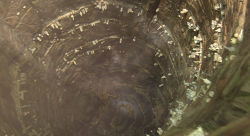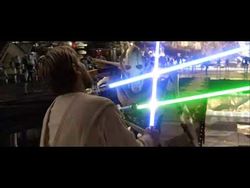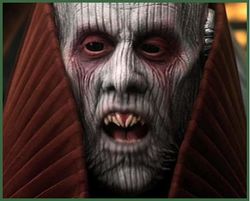User:Tereglith42/Utapau
“What the heck is this crap? Utapau's not an American town, it's a planet from Ep. III! Have you got bantha-fodder for brains, you scruffy-looking nerfherder?”
“Which town? Ah, the one with the pillowcases? Yes, that was one of my more brilliant business moves... you'd be surprised the number of things that two [or, based on Wilde's behavior, probably more] men so inclined can do with a corduroy pillowcase”
Utapau[edit | edit source]
Utapau (population 9,716) is a town in Southern Alabama in which a battle was fought during the Civil War, as told in the third volume of George Lucas' series of documentaries entitled The Civil War. Lucas's representation of the town and the battle is, for the most part, highly accurate. In addition to being the site of the historic battle, Utapau is home to some of the largest sinkholes in the nation and produces much of the country's corduroy supply, an industry which has been the base of the town since its start.
Founding[edit | edit source]
In 1765, one of Oscar Wilde's business ventures resulted in a large factory being built in the middle of Alabama's largest fields of sinkholes. The factory was dedicated solely to producing corduroy pillowcases, which had, for a reason perhaps best left as a mystery to scholars, become a fad in France. As driving a carriage across the pockmarked terrain was quite dangerous, many factory workers opted to kick the carriage across it instead. When this failed (except for the notable instance of one Charles H. Norris, who, as the Birmingham Inquirer reports, "did kick hif carriage in a peculiar, twirling manner, and with fuch great vigour that it did fly upwardf for a great diftance, continuing towardf the factory until, at laft, it diffapeared from the vifion of all prefent."), the workers decided to move their houses closer to the factory.
This eventually resulted in the formation of a small town around the factory, much of which took advantage of the natural sinkholes to provide walls for structures. Many Utapauans still live in the sinkholes to this day. The town was officially recognized by the Alabaman 'government' (widely believed to be composed of three men named Ralph who decide on things while drunk) on February 19, 1779, during the middle of the Revolutionary War. This day is now commemorated in the town by doing things exactly the same as they are done any other day.
The Battle of Utapau[edit | edit source]
What UTapau is most famous for today is the Battle of Utapau, as portrayed in the most recent of George Lucas' acclaimed Civil War documentaries The Civil War: Episode III: Revenge of the Confederacy. The Battle of Utapau was part of the Overland Campaign, a series of battles waged by Union General Ulysses S. Grant (born Obi-wan Ulysses Kenobi) against Confederate General Robert E. Lee (nicknamed "General Grievous" by Union soldiers due to the grievous losses he incurred on the battlefield.)
In the Spring of 1862, Utapau, previously a bastion of Union idealism due to the liberal influence of Oscar Wilde, was occupied and scoured by Confederate troops. The factory in Utapau had, during the wartime effort, switched from producing corduroy pillowcases to producing uniforms for the Union. Thus, capturing the factory was strategically important to the Confederates, as its loss would mean that many Union soldiers would be forced to walk around naked, leaving them to fall victim to the various hemophagic bugs of the South, as well as AIDS, depending on what sort of soldier they were marching in front of. The Confederates expected the taking of the town to be quite easy, but were me with harsh resistance by townsfolk, particularly the same Charles H. Norris, who, as the Inquirer once again tells us, "did battle mightily with the Rebel foldierf, hif kickf inflicting af much damage af a cannonade fired at clofe range." (It is interesting to note that soon after the battle of Utapau, the Inquirer's typsetter in charge of the letter 's' was fired). Robert E. Lee was called in to oust Norris, and he arrived with an unknown secret weapon that historians now believe was either a nuclear missile or Jackie Chan. The weapon succeeded in removing Norris from the town.
Grant Moves In[edit | edit source]
Upon getting wind of Lee's position to the town, General Grant decided that it was best to check out the rumor. If it was true, it would offer him a chance at catching the Union's greatest enemy, as well as have a legitimate excuse for not giving his wife an anniversary present on time. Grant went down himself to consult with the townsfolk, who informed him that Lee had already taken over the town. Alarmed, Grant called for a force of C.L.O.N.E.S. (Confederacy-Licking Old and New Extreme Soldiers) to be brought down from the Army of the Potomac forces stationed in New York City. After a period of about two weeks (shortened for time reasons in the documentary), the C.L.O.N.E.S. arrived on a series of steamboats and took on the Seperatist forces from the outside, while Grant tracked down Lee. The two engaged in a dramatic fight with their dueling sabers, one of many such battles being fought during the overland campaign.
Seperatist Defeat[edit | edit source]
The overwhelming force of C.L.O.N.E.S., coupled with the fact that there was nowhere for the Confederates to run to, as they had retardedly stationed themselves at the bottoms of sinkholes, overwhelmed the Confederate forces, and they were defeated within minutes. The fight between Grant and Lee ended when, after a sword-fighting horse-race through the city, Grant finally realized that he had had a sidearm all along and shot Lee in the chest. Lee died of the wound, but not before columns of fire inexplicably shot out of his eye sockets, which, according to one historian, "must have looked pretty damn wicked!"
Grant Betrayed[edit | edit source]
At the end of the Battle of Utapau, Union Secretary of War Stanton revealed that he was actually a woman named Shirley. Shirley then revealed that she had actually secretly been controlling both sides of the war, and sent telegrams speeding across the nation telling her special C.L.O.N.E.S units to destroy all Union Generals, in a bid to take over the country. The C.L.O.N.E.S. in Utapau began attacking Grant, and took down his steed with a light cannon, sending him to the bottom of a sinkhole. However, soon after Stanton sent out his message, Abraham Lincoln came back from one of his vampire-hunting missions and chopped off the traitor's head with an ax. (In the documentaries, this event was delayed nineteen years and assigned to Darth "Stonewall" Jackson Vader)
The Part You Always Skip Over Because You're Bored of All this History and Want to Get to Notable Residents or Crap Like That[edit | edit source]
Although the rest of Utapau's history is not as well-publicized as the Battle, there are a number of notable events that you know are being edited about by residents of the town because nobody outside the town would ever care at all about them. So why do you?
First Electric Lights in Alabama[edit | edit source]
Utapau was the first town in Alabama to recieve full electric wiring, including public streetlamps and power for the Corduroy Pillowcase factory. The decision came about after much deliberation by the Alabama departments of Public Works and Commerce (aka the second and third drunk Ralphs). A statement issued by the third Ralph on the decision read as follows:
| “ | Well shoot! I had no idear that we as a state were this far behind the rester the world! In an effort to recterfy the sitcheration, I've decided to 'lectrify our town of |
” |
Operation began on the electrification in 1998 and was finished in 2003, with only ten casualties.
The Flood of 1895[edit | edit source]
According to the great-grandma of this one kid's friend, there was a large flood during the summer of 1895, and half the town's sinkholes were filled with water. Not much more is known, as the kid's mom showed up five minutes into the conversation. Way to go, kid's mom.
Civil Rights Movement and Desegregation[edit | edit source]
The First Drunken Ralph has stated that he will "probably get around to that desegration thing sometime soon."
Residents[edit | edit source]
The unique combination of good old fashioned Appalachian inbreeding, the complete absence of any orthodontists, and the universal usage of Corduroy Pillowcases gives the residents of Utapau a highly unique look, which as been described by various people as "the creepiest thing I've ever seen that wasn't named Britney Spears", "Exactly like Britney Spears", "Like my uncle Rick crossed with Britney Spears", and by one historian as "pretty damn wicked."
The most common Utapauan occupation has always been and continues to be working in the Corduroy Pillowcase factory, although it is unclear who still buys corduroy pillowcases, as they have been unpopular in France since 2009 - wait, now they're popular again there! Oh, never mind, they're out of style again. Other Utapauan jobs include working the fields around the town and at least one Utapauan who is the world's second professional face-smoother (the first being employed by Joan Rivers)
Utapauans are noted for being exceptionally thin, which is due entirely to the fact that there is no McDonald's restaurant in the town, because McDonalds is the only reason that anyone ever gets fat.
Notable Residents[edit | edit source]
Normally, this section would contain a list of notable residents that you could skip down to from the history section. However, no permanent resident of Utapau has ever done anything of any note, except for Charles H. Norris, but he didn't even live there his whole life and is too awesome to be contained in a sub-sub-heading.
Media[edit | edit source]
Newspapers[edit | edit source]
Despite its 67% adult illiteracy rate, Utapau has a newspaper all its own, the Utapau Papery News Thing. Operated by the Appalachia Orgainzation fer Informerating the Public, it consists of two legal-sized pieces of paper with simple, clear language and pencil-drawn pictures on them which detail local news, put out twice a week in the town's two grocery stores. It has an estimated readership of 97 people per issue.
Film[edit | edit source]
Two films have been made in Utapau. The Utapau sequence of Lucas' documentary, of course, was filmed there, as he prided himself on filming on location. The second, less well-known film is called Manos:Hands Of Fate, which, despite its obscurity, almost always tops lists of the best films ever made. In fact, film is the area in which the history of Utapau is most distinguished.
Radio[edit | edit source]
It would appear that Utapau is the origin of a radio station that subjects listeners to "Don't Break My Heart (My Achy Breaky Heart)" by Billy Ray Cyrus 24/7. Various civil rights activists have attempted to shut them down, but all attempts so far have failed. The U.S. Government is currently considering a "nuke it from orbit" strategy to end this hideous affront to human decency.
Television[edit | edit source]
It is a little-known fact that the TV show "Green Acres" was actually a reality show that sent a real millionaire couple to live in Utapau for several years. Producers deliberately chose the more normal-looking citizens to interact most often with the couple, although Sam Drucker is proof that by the end of the casting call they were starting to run out.



